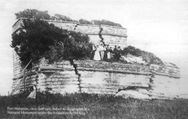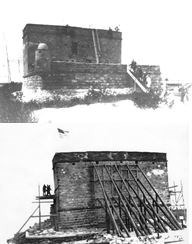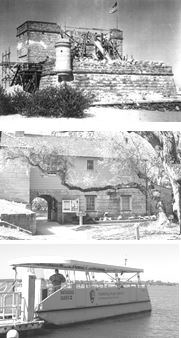
Early Stabilization 
In early 1924 another authorization was made to conduct repairs on the fort. These repairs included tearing down and rebuilding portions of the East and South walls of the gun platform. Many stones were removed and much of the original stone was used in reconstructing these walls. Later that year, President Calvin Coolidge issued an order which declared Fort Matanzas a National Monument. This gave responsibility of the monument to the U.S. Quartermaster General and now required the Fort administered in the same manner as the national military parks. Among the many projects undertaken at this time was a $750 allotment to reconstruct a sentry box. It was believed that this structure served no useful purpose for Matanzas but was recommended in the interest of history. As a cost saving measure, the sentry box was reconstructed from brick and covered with cement plaster and coquina gravel. By mid-1929, it was noticed that this box, like the original was breaking away from the fort walls. Due to the size of the cracks, it was decided best to remove the box and reconstruct another. A metal band and bars were added at the base to prevent a new box from breaking away and the new sentry tower (the one standing today) was built using coquina to harmonize with the rest of the fort. Also, the North tower of the fort showed noticeable bulging to the sides. To prevent further movement, iron tie-rods were hidden within the walls of the fort and helped stabilize the structure. 
The National Park Service took over full operation of Fort Matanzas and Fort Marion (the Castillo) on July 1, 1935. At the height of the Great Depression the Public Works Administration (PWA), not to be confused with the Works Progress Administration (WPA) allotted funding specifically for restoration of the old watchtower. Projects included a complete reconstruction of the tower arch and a portion of the south side of the tower wall. Also, for the first time in the history of Fort Matanzas, a sea wall was installed around the building in 1936 to prevent further erosion. Across the Matanzas River, land was set aside to build a visitor center complex. This project was awarded to a local Jacksonville construction company to lead the building construction. This visitor center still stands in operation today! The fort’s rotting iron tie-rods from earlier restoration were replaced with steel and still help secure the tower walls from further separation today. Over the years, additional projects have been undertaken for the continued preservation and public use of the monument. The National Park Service began the current ferry service in 1972 when a local boat captain started a concession operation to take people to the fort. Over the years, the monument has also gone through a series of different boat docking facilities. The first was wood, followed by aluminum, and later upgraded to a floating concrete platform which now houses the park’s ferry service. Today the monument has two Ferry Boats which carry over 60,000 visitors a year, while the overall park receives over 600,000. Today’s funding for future projects actually comes from the admission fees taken at the Castillo de San Marcos National Monument. A percentage of those sales help keep the boats in service and fund future projects geared to preserving and maintaining this national treasure for the enjoyment of future generations. Back to "Stories" |
Last updated: June 24, 2017
